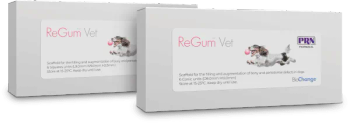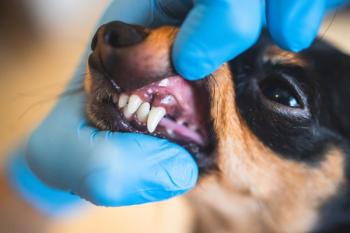
Just Ask the Expert: Are there alternatives to surgery for a fractured tooth?
I have a feline patient with an upper right canine fractured at the gumline. The cat's owner cannot afford surgery. Is there anything I can do to help keep this patient comfortable?
Dr. Carmichael welcomes dental questions from veterinarians and technicians.
To ask your question, e-mail:
With the subject line: Dental Questions
Q: I have a feline patient with an upper right canine fractured at the gumline. The cat's owner cannot afford surgery. Is there anything I can do to help keep this patient comfortable? Would a sealant help? Along those lines, if an owner of a cat with a feline odontoclastic resorptive lesion (FORL) cannot afford extraction, are there other treatment options I can provide?
Thank you for your time,
Sara Liddell, DVM
A: Dental crown fractures are classified as complicated or uncomplicated, based on whether the pulp chamber has been exposed. What you are describing is most likely a complicated crown fracture. In cats, the pulp chamber extends almost all the way to the coronal tip.
Left untreated, complicated dental fractures can be a source of chronic pain and can lead to pulpitis, pulpal necrosis, osteitis, tooth root resorption, draining sinus tracts, facial swelling, and tooth loss.
Few options are available for treating complicated crown fractures. These options include endodontic treatment (root canal therapy) or dental extraction. Vital pulp therapy and direct pulp cap restoration are a third option, if performed within hours of the injury. So other than root canal therapy or extraction, no other treatment option is available for your patient with a fractured canine. As to your second question concerning FORLs, extraction is the only viable treatment. (By the way, the American Veterinary Dental College [AVDC] has determined that a feline odontoclastic resorptive lesion, or FORL, should now be referred to as tooth resorption. For more information on this and other nomenclature issues, please visit the AVDC Web site,
The important concept here is to be an advocate for your patients. Oftentimes, owners do not appreciate that their cats are in pain, and it is tempting to offer a wait-and-see approach. This is never in the patient's best interest.
Daniel T. Carmichael, DVM, DAVDC
Veterinary Medical Center
75 Sunrise Highway
West Islip, NY 11795
The intent of Just Ask the Expert is to address non-urgent medical questions and to share this information through the Web site with other practitioners. The recommendations are for informational purposes only. It is each clinician's responsibility to carefully weigh these recommendations and determine the right course of action for each patient. Please verify any drug dosages discussed. Questions may be edited for style and length.
Newsletter
From exam room tips to practice management insights, get trusted veterinary news delivered straight to your inbox—subscribe to dvm360.






